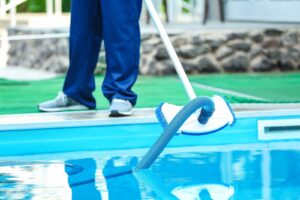Introduction:
When it comes to maintaining a pristine swimming pool, identifying and addressing leaks is essential. One effective method for leak detection is pressure testing. By pressurizing the pool’s plumbing system, technicians can pinpoint leaks and weak points that lead to water loss. In this article, we will explore the process of pressure testing for pool leaks, its benefits, and how it ensures accurate repairs.
I. The Process of Pressure Testing for Pool Leaks
Pressure testing is a systematic approach that involves pressurizing the pool’s plumbing system and monitoring for any significant pressure drop, indicating the presence of leaks. Let’s delve into the step-by-step process:
1. Gathering the necessary equipment:
Before starting the pressure test, ensure you have the required tools, such as a pressure testing kit, including a pressure gauge, test plugs, and an air compressor or hand pump.
2. Preparing the pool:
To prepare the pool, adjust the water level to its normal state and turn off the filtration system. Close all skimmers, main drains, and return lines to isolate the plumbing system.
3. Selecting a Testing Point
Choose an appropriate location for the pressure test. Typically, a dedicated line like the main drain or a return line is selected. Refer to the pool’s plumbing diagram or consult a professional for guidance.
4. Installing the test plug:
Insert the test plug into the chosen testing point, ensuring it is securely placed to prevent air or water from escaping during the test.
5. Pressurizing the system:
Connect the air compressor or hand pump to the test plug and gradually increase the pressure to the recommended range. Consult the manufacturer’s guidelines or seek professional advice for the appropriate pressure level.
6. Monitoring the pressure gauge:
Once the system is pressurized, monitor the pressure gauge for any significant drop. A sudden decrease indicates the presence of a leak in the plumbing system.
7. Inspecting the pool:
While the system is pressurized, visually inspect the pool’s surface, plumbing connections, and equipment for any signs of leakage. Look for water seepage, damp spots, or bubbling areas that may pinpoint the leak’s location.
8. Testing different sections:
If the pressure remains stable and no leaks are detected, proceed to test other sections of the plumbing system. Repeat the process by installing the test plug and pressurizing the system to check for leaks in different areas.
9. Documenting and repairing leaks:
When a leak is detected, document its location and the pressure reading. Once the test is complete, release the pressure and initiate the necessary repairs. Depending on the severity of the leak, faulty valves, seals, or pipes may need replacement.
10. Retesting and ensuring integrity:
After repairs, conduct a follow-up pressure test to ensure the leaks have been successfully resolved. This step is crucial for verifying the integrity and efficiency of the pool’s plumbing system.
II. The Benefits of Pressure Testing for Pool Leaks
Pressure testing offers several advantages when it comes to detecting and repairing pool leaks:
1. Accuracy and precision:
Pressure testing is a highly accurate method for locating leaks, allowing for precise repairs. By identifying the specific points of leakage, technicians can address the issues promptly, minimizing damage and water loss.
2. Comprehensive leak detection:
Pressure testing allows for a thorough examination of the entire plumbing system, ensuring that all potential leaks are identified. This comprehensive approach helps prevent future problems and ensures the pool’s long-term integrity.
3. Non-invasive technique:
Unlike other leak detection methods that may require invasive procedures, pressure testing is a non-invasive technique. It doesn’t involve drilling or cutting into the pool’s surface, minimizing disruption and additional repair work.
III. Using Pressure Testing in Con
junction with Other Methods
To enhance leak detection accuracy, pressure testing is often combined with other methods:
1. Thermal imaging:
Thermal imaging is a non-invasive method that uses infrared technology to detect temperature differences on the pool’s surface caused by water leaks. When used alongside pressure testing, it provides an additional layer of confirmation, increasing the overall effectiveness of leak detection.
2. Dye testing:
Dye testing involves adding a colored dye to the pool water, allowing technicians to visually identify areas where the dye escapes, indicating a leak. Combining dye testing with pressure testing helps pinpoint the exact location of leaks and facilitates targeted repairs.
Conclusion:
Pressure testing is a crucial step in identifying and repairing pool leaks. By following the outlined process, pool owners and technicians can efficiently locate leaks and ensure the integrity of the plumbing system. Remember, if you’re unsure about conducting a pressure test or encounter difficulties, it’s best to seek assistance from a professional pool technician with expertise in leak detection and repair. By taking proactive measures to detect and repair leaks, you can enjoy a well-maintained pool and avoid potential water loss and damage.





No comment yet, add your voice below!